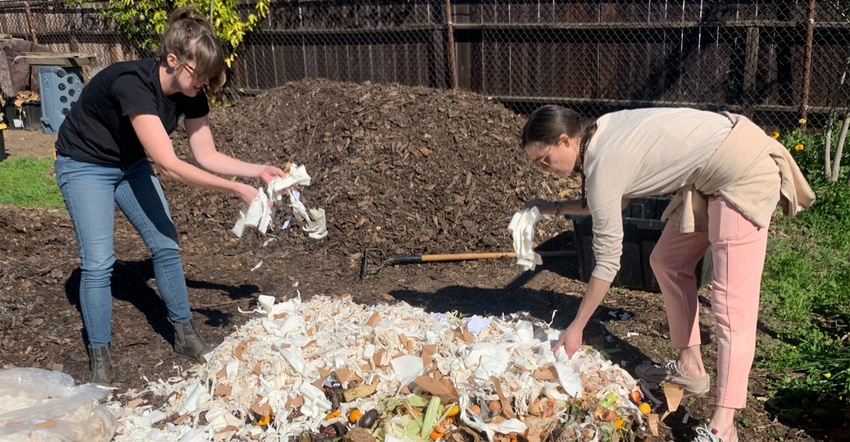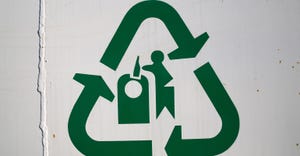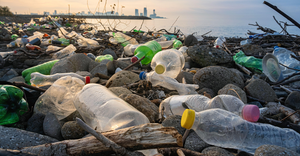“What we aim to do is work with businesses to create a circular flow. We recreate, and the company puts the product back on their shelves rather than make items out of virgin material,” says Christina Johnson, Upcycle it Now co-founder.

California’s largest city – Los Angeles – prides itself for having what it sees as a culture that values sustainability and circularity. Setting aggressive landfill diversion and recycling goals; advancing product stewardship programs, and other environmentally-centered initiatives are at the heart of the work to support that culture; but like many municipalities, LA still has big trash problems, including massive quantities of textile waste. And as one of the largest garment manufacturing hubs in the U.S., much of that waste is generated at its own door.
LA is trying to curb the rapid pile up of the industry’s discards through a pilot, in partnership with California Product Stewardship Council (CPSC) and industry, to recover and recirculate materials from manufacturers, retailers, and commercial/institutional generators.
The project aims to demonstrate, and show the potential for, several practices: upcycling scraps to make new, one-of-a-kind pieces; fiber-to-fiber recycling, where material too small to upcycle is made into pellets to go into other textiles; and composting organic, untreated materials that can’t be salvaged for clothing.
There’s another hopeful ambition for down the road: developing a “textile hub,” which would be a centralized location to receive, recycle, repurpose, and distribute from.
LA pilot participant, Upcycle it Now, is a designer and manufacturer that makes accessories from postconsumer garments and manufacturers’ scraps.
“What we aim to do is work with businesses to create a circular flow. We recreate, and the company puts the product back on their shelves rather than make items out of virgin material,” says Christina Johnson, Upcycle it Now co-founder.
“We are small, but we’ve been at this for 11 years and have seen what works and what doesn’t,” says Johnson, who has worked on upcycling pilots with The North Face, Arc'teryx, and a few other outdoor clothing brands.
With this new LA project, Upcycle it Now is in the ideation phase, exploring for instance the possibility of making one-off pieces, maybe a tote bag or fanny pack, from used, worn uniforms that would otherwise have been discarded.
Comparing this work to more traditional manufacturing, Johnson says the latter is done on a linear trajectory. Extracted materials become a fabric. They go to cut and sew to make product, and then go to market. Upcycling does not follow that predictable, straight line.
“You have more stakeholders. You pull feedstock from more unconventional sources. And you have a lot more conversations. So it can be more work to make all the pieces fit, but there’s opportunity to be real resourceful as you try to determine where materials will come from and what you will do with them,” she says.
Similar to other small upcyclers, Johnson has flexibility not only in terms of what she can make, but with quantities she can work with. And she is open to design input, leaving the door open to possibilities.
“With this pilot, we have no specific market identified yet, but we have great ideas for unique pieces that we can possibly sell through a designer or a smaller brand and have it be a very cool kind of LA signature piece. Something with a local story rather than something bought at a department store. It comes from LA and was redesigned in LA to be a collector’s item,” she says.
Pilot participant California Cloth Foundry is a natural fashion and fabric manufacturer. It buys fibers from farmers; makes yarn to be spun into textiles; and has its own signature clothes, which are botanically dyed and botanically printed (using plant-based chemicals and materials).
The small operation has held onto its cutting room waste for a couple of years with the intention to eventually recycle it but hasn’t generated enough to be collected for that purpose. Through the pilot it’s tapping into another option: the scraps will be collected by Compostable LA who will process them and deliver the end product to a farm.
Because the material is plant-based with no harmful chemicals it should make good feedstock. Compostable LA has so far collected a couple hundred pounds of these scraps, including those mixed in with pattern paper. California Cloth Foundry will take back plastic, so its processing partner does not have to sort or dispose of it.
“CPSC will collect data on how our materials compost and how they impact soil, and we will too,” says Lydia Wendt, founder and CEO of California Cloth Foundry.
“This is soil, to skin, back to soil. So, whatever we are extracting from the earth to make our products can go back to the earth. I’m excited that our textiles, with food-grade ingredients, are going back into the soil to grow more food,” she says.
If it can be scaled, Wendt envisions potential for meaningful impact in the surrounding region, considering that California is a big agriculture state.
“We grow a lot of food. That’s what our state does so well. So, we are taking waste generated in California and turning it into something beneficial for our soil,” she says.
As part of the LA project, the city envisions developing an online database to facilitate exchanges between manufacturers, textiles processors, and haulers involved with repurposing and reuse, but is also looking into the economic feasibility of a physical “textiles hub” where recovery, repair/repurposing can take place.
CPSC is conducting the feasibility study and also developing a map of reuse, repair, and recycling service providers as a first step to an online platform, or these identified providers can be part of the physical “hub” should it materialize, says Joanne Brasch, special projects manager, California Product Stewardship Council.
The project has accomplished a lot to date, says Michael Simpson, division manager, LA Sanitation and Environment, circular leader.
“We’ve collected a lot of data on characteristics of the city’s textiles waste stream; identified processes for use of this discarded material; and in a couple of months, we should have a concept report for a possible physical textiles hub,” he says.
“We want to make our city more livable and reduce the climate impact of textiles. [As part of that] we will work with our textile producers, sorters, and other providers to find a unique way to put manufacturing surplus into a circular economy and at the same time divert from landfill, and hopefully increase our green jobs. There are social, environmental, and economic benefits to using circular principals to recycle and repurpose this material.”
About the Author(s)
You May Also Like




